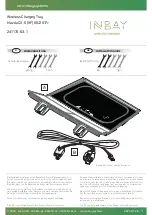
Those grades represent the tire's ability to stop
on wet pavement as measured under controlled
conditions on specified government test surfa‐
ces of asphalt and concrete. A tire marked C may
have poor traction performance.
The traction grade assigned to this tire is based
on straight-ahead braking traction tests, and
does not include acceleration, cornering, hydro‐
planing, or peak traction characteristics.
Temperature
The temperature grades are A, the highest, B,
and C, representing the tire's resistance to the
generation of heat and its ability to dissipate
heat when tested under controlled conditions
on a specified indoor laboratory test wheel. Sus‐
tained high temperature can cause the material
of the tire to degenerate and reduce tire life, and
excessive temperature can lead to sudden tire
failure. The grade C corresponds to a level of
performance which all passenger car tires must
meet under the Federal Motor Vehicle Safety
Standard No. 109. Grades Band A represent
higher levels of performance on the laboratory
test wheel than the minimum required by law.
Temperature grade for this tire
The temperature grade for this tire is es‐
tablished for a tire that is properly inflated and
not overloaded. Excessive speed, underinfla‐
tion, or excessive loading, either separately or in
combination, can cause heat buildup and pos‐
sible tire failure.
If necessary, have the vehicle towed.◀
M+S
Winter and all-season tires with better cold
weather performance than summer tires.
Tire tread
Summer tires
Do not drive with a tire tread depth of less than
0.12 in/3 mm.
There is an increased danger of hydroplaning if
the tread depth is less than 0.12 in/3 mm.
Winter tires
Do not drive with a tire tread depth of less than
0.16 in/4 mm.
Below a tread depth of 0.16 in/4 mm, tires are
less suitable for winter operation.
Minimum tread depth
Wear indicators are distributed around the tire's
circumference and have the legally required
minimum height of 0.063 in/1.6 mm.
They are marked on the side of the tire with TWI,
Tread Wear Indicator.
Tire damage
General information
Inspect your tires often for damage, foreign ob‐
jects lodged in the tread, and tread wear.
Notes
Driving over rough or damaged road surfaces, as
well as debris, curbs and other obstacles can
cause serious damage to wheels, tires and sus‐
pension parts. This is more likely to occur with
low-profile tires, which provide less cushioning
between the wheel and the road. Be careful to
avoid road hazards and reduce your speed, es‐
pecially if your vehicle is equipped with low-pro‐
file tires.
Seite 244
Mobility
Wheels and tires
244
Online Edition for Part no. 01 40 2 900 735 - 03 12 490
Summary of Contents for M6 convertible 2012
Page 2: ......
Page 9: ...Notes 9 Online Edition for Part no 01 40 2 900 735 03 12 490...
Page 10: ...Online Edition for Part no 01 40 2 900 735 03 12 490...
Page 28: ...Online Edition for Part no 01 40 2 900 735 03 12 490...
Page 138: ...Online Edition for Part no 01 40 2 900 735 03 12 490...
Page 149: ...Saving fuel Driving tips 149 Online Edition for Part no 01 40 2 900 735 03 12 490...
Page 150: ...Online Edition for Part no 01 40 2 900 735 03 12 490...
Page 169: ...Navigation system Navigation 169 Online Edition for Part no 01 40 2 900 735 03 12 490...
Page 170: ...Online Edition for Part no 01 40 2 900 735 03 12 490...
Page 204: ...Online Edition for Part no 01 40 2 900 735 03 12 490...
Page 235: ...ConnectedDrive Communication 235 Online Edition for Part no 01 40 2 900 735 03 12 490...
Page 236: ...Online Edition for Part no 01 40 2 900 735 03 12 490...
Page 272: ...Online Edition for Part no 01 40 2 900 735 03 12 490...
Page 296: ......
















































